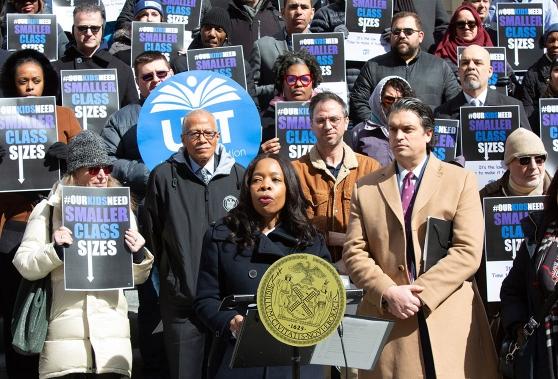‘Follow the law’

It’s no secret that a smaller class leads to better academic outcomes for our students,” said City Council Education Committee Chair Rita Joseph, a former teacher, prior to an oversight hearing where she grilled DOE officials on their plans to implement the state’s historic class size law. UFT Assistant Secretary Michael Sill (right) joined her at the rally.
The UFT has accused Mayor Eric Adams and the city Department of Education of trying to sabotage the implementation of the state law lowering class size in New York City public schools.
The state has significantly increased aid for city schools to finance the cost of lowering class sizes. But the mayor and the DOE are “inflating cost estimates, inventing excuses and gaslighting the public,” UFT Assistant Secretary Michael Sill said on Feb. 29 at a rally before a City Council oversight hearing on class size. “It’s the policy equivalent of saying the dog ate my homework.”
He and others at the rally called on the DOE to implement the more than 50 recommendations made by the chancellor’s Class Size Working Group of educators, parents and other education advocates. The recommendations include increasing capital funding for new seats, supporting schools that have class sizes under the new caps so they remain in compliance, and dedicating more resources for teacher recruitment.
In his testimony at the hearing, Sill said Mayor Adams and the DOE must stop treating the state’s class size law as if it were optional. “Lowering class sizes in New York City is not an experiment, a wish list, an ‘unfunded mandate’ or even another expenditure competing for DOE funding,” he said. “It’s the law.”
UFT members, together with parents and community leaders, successfully pushed for the 2022 law, which requires all classes to meet the following size limits by September 2028: 20 students in kindergarten through grade 3, 23 in grades 4–8, and 25 in grades 9–12. The DOE has met the 20% requirement for the current school year, even as average class sizes increased for elementary and middle schools citywide.
City Council Education Committee Chair Rita Joseph called the DOE’s implementation plan “vague.” She and her fellow council members spent several hours peppering DOE officials at the hearing with questions on the timing, planning, funding and implementation of the law.
Joseph, also a member of the Class Size Working Group, championed legislation later passed by the City Council on March 19 that requires the city to report actual class sizes — not averages — and expand reports on the number of students in special programs.
Olympia Kazi, the mother of a 1st-grader at PS 187 in Washington Heights, said her school has added student teachers and parent volunteers to help with large classes. It is obvious, she said, that the DOE is not on track to meet the law’s requirements in future years.
“This idea of scarcity that our mayor is trying to push through is a shame and we all know it, so please follow the law,” said Kazi.
Parent Tiffanie Placeres of Queens said her daughter, who is now 8, got lost in her 2nd-grade class of 32 last year and suffered academically as a consequence. Teachers are great, she said, “but there is not enough time in a day to connect with every one of the students.”
English teacher Terrain Chambers Reeves, the chapter leader at Edward R. Murrow HS in Brooklyn, lit into the mayor and the DOE. “Let’s stop crying poverty,” she said. “Let’s ensure that we provide the most critically important expenditure with the greatest return to the education of our children. We know better, so let’s do better.”